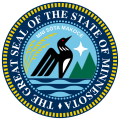| |||||||||||||||||||||
| |||||||||||||||||||||
| |||||||||||||||||||||
The 1890 Minnesota Secretary of State election was held on November 4, 1890, in order to elect the Secretary of State of Minnesota. Republican nominee Frederick P. Brown defeated Democratic nominee Axel T. Lindholm, Farmers' Alliance nominee Michael F. Wesenberg and Prohibition nominee Hans S. Hilleboe. [1]

